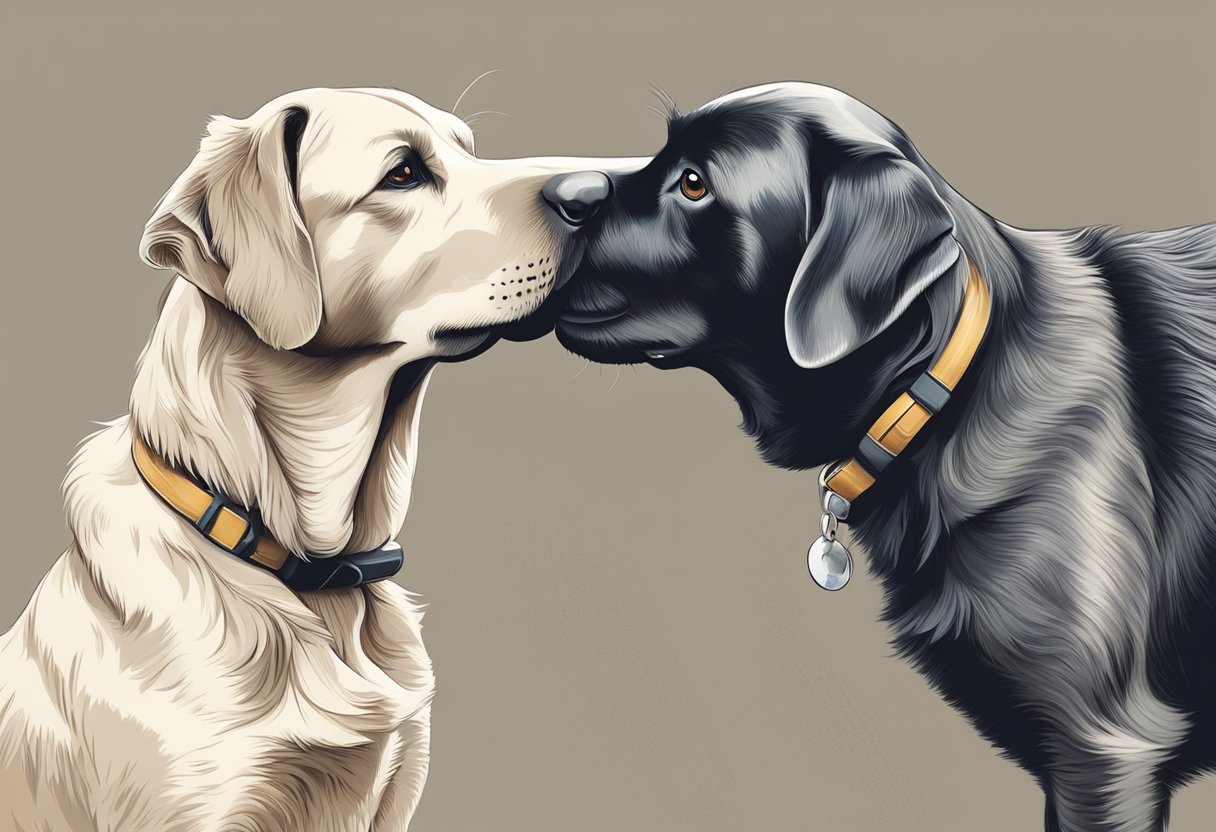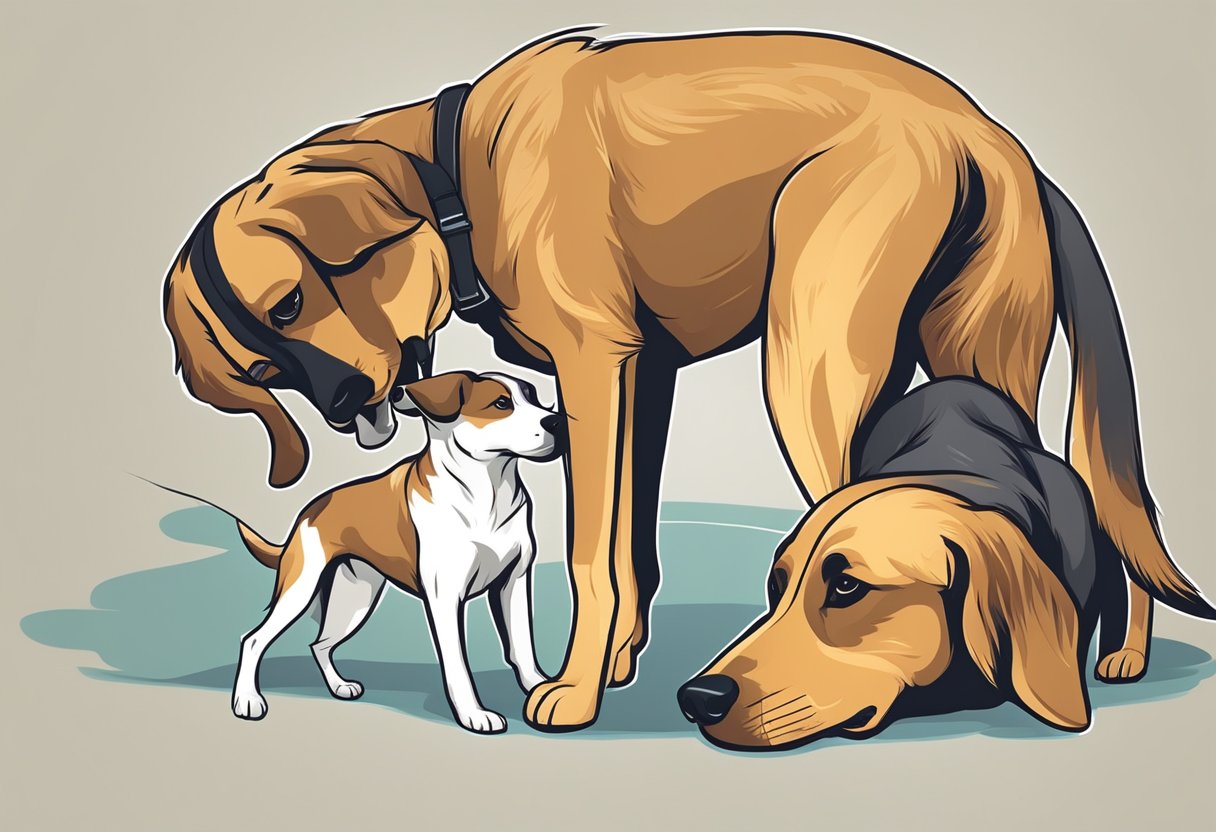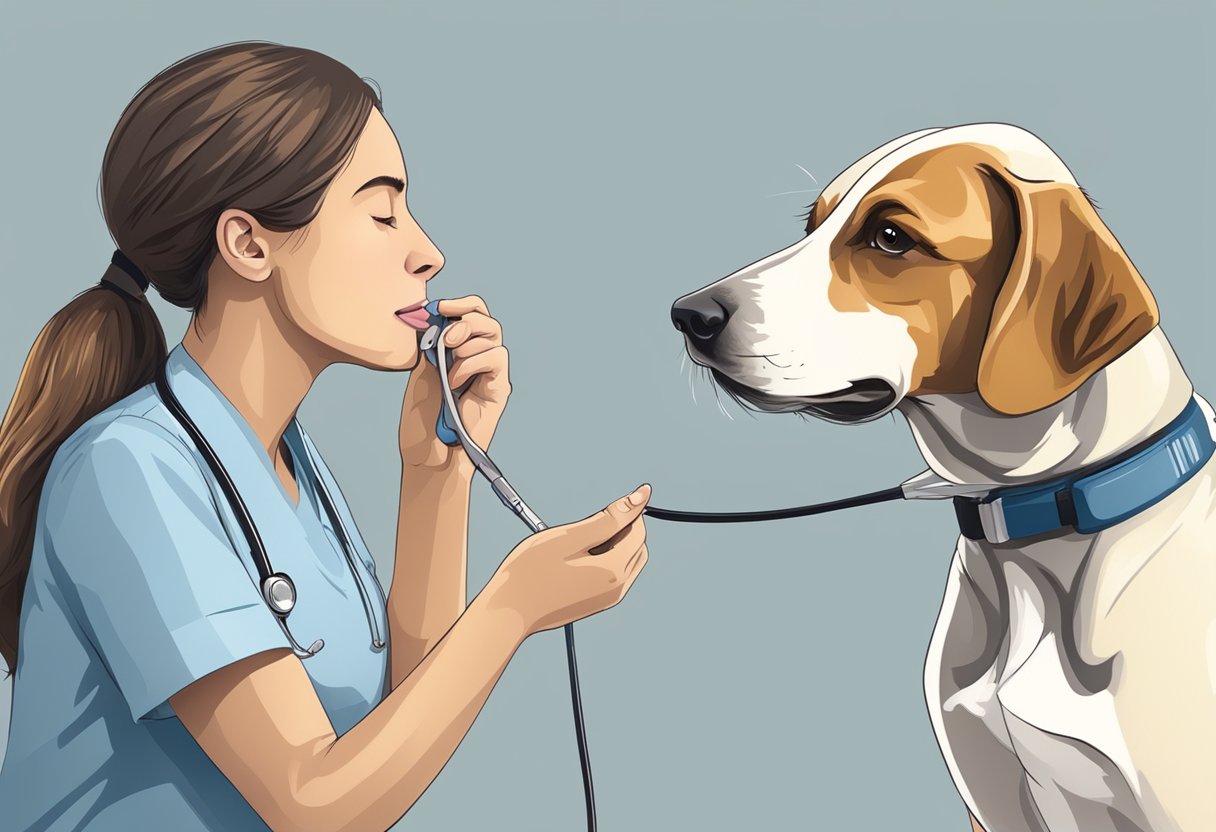Dogs exhibit a range of intriguing behaviors, one of which is their tendency to sniff human ears. This behavior may seem peculiar, but to our canine companions, using their powerful sense of smell to explore their environment is completely natural. When a dog sniffs a person’s ear, they are engaging with the world in one of the ways they know best. Dogs depend heavily on their olfactory system to gather information, and the unique scents produced by human ears can provide them with a bounty of sensory data.

Understanding why dogs are drawn to human ears requires insight into canine behavior and their sensory capabilities. A dog’s nose is highly sensitive, capable of detecting odors in minute concentrations, which is why ears, with their distinct scent profile, can be so appealing. It’s not just curiosity at play; sniffing can be a form of communication, an expression of affection, or even a health check. Sometimes, a dog may be drawn to an ear due to an underlying medical issue or simply because they’ve learned that this behavior garners attention.
Key Takeaways
- Dogs’ advanced olfactory abilities lead them to sniff ears as a way to explore and gather information.
- Ear sniffing can be a sign of various behaviors, from showing affection to detecting health issues.
- Observing this behavior provides insight into both the complexity of a dog’s sensory world and its interactions with humans.
Canine Olfactory System
The canine olfactory system is a complex and sensitive arrangement that enables dogs to detect and process an array of scents, playing a central role in their interaction with the environment and with humans, such as the behavior of sniffing ears for information.
Understanding the Dog’s Sense of Smell
Dogs possess an extraordinary sense of smell that is central to their perception of the world. The main olfactory epithelium (MOE) and the vomeronasal organ (VNO) are two key components in their olfactory system, allowing them to pick up chemical compounds that humans are oblivious to. This heightened sense can detect odor concentrations at nearly one part per trillion, which is far beyond human capability.
Role of Sniffing in Dog Behavior
Sniffing is not merely a receptive action for dogs; it is active and purposeful, providing essential mental stimulation and information about their environment. During a walk, a dog’s constant sniffing is a way to gather data about what’s happening around them. It allows them to be aware and alerts the handler to changes or specific points of interest.
Sniffing as a Social Interaction
For dogs, sniffing can also be a social tool. They greet and gather information about each other through sniffing. When a dog sniffs a human ear, it might be seeking affection, offering attention, or engaging in playful interaction. This behavior allows them to communicate in their language and build a social connection.
Differences Among Dog Breeds
Distinct dog breeds have different capacities when it comes to their sense of smell. For instance, Bloodhounds, Spaniels, and Terriers are among the breeds with highly developed olfactory senses. Bloodhounds, known for their tracking ability, can follow a scent trail for miles. Spaniels and Terriers also have keen noses, which historically aided hunters in locating game.
Health and Hygiene
The health and hygiene section discusses essential aspects of canine ear care, focusing on prevention and treatment of ear issues. This includes understanding infections, maintaining cleanliness, recognizing signs of problems, and exploring treatment options.

Ear Infections in Dogs
Ear infections in dogs are commonly attributable to bacteria or yeast, leading to unpleasant odor. Floppy-eared breeds may be especially prone to infections due to limited air circulation. Discharge and redness are typical signs of an ear infection, which should be addressed promptly by a veterinarian.
Ear Cleaning and Maintenance
Regular ear cleaning can prevent the accumulation of wax, debris, and dirt that can lead to infections. A proper ear cleaning solution applied with a cotton ball—not alcohol which can irritate—should be used. It’s imperative to avoid inserting anything deep into the dog’s ear canal to prevent injury.
Signs of Ear Problems
Recognizing early signs of ear problems such as head shaking, itchiness, inflammation, or pain can prevent more serious complications. Dogs with dirty ears might also exhibit behavioral changes due to discomfort. These symptoms necessitate a visit to the veterinarian.
Treatment Options for Ear Issues
Treatment for an ear problem usually involves a swab test to identify the causative agent, followed by targeted medications, which may include antibiotics, antifungals, or steroids. In the treatment of bacterial or yeast infections, adherence to the prescribed regimen is crucial for full recovery.
For more detailed information on canine ear conditions and maintenance, consulting a trusted veterinarian is recommended. For instance, they can provide insights on the best methods to clean your dog’s ears or handle a dog’s ear infection symptoms.
Behavioral Aspects

In considering why dogs engage in ear-sniffing behavior, it’s essential to recognize that this action can be a complex interplay of the canine’s curiosity, desire for attention, and their response to various stimuli. Analyzing the behavioral aspects offers insight into how dogs communicate and interact with their environment.
Curiosity and Exploration
Dogs explore the world primarily through their nose. Sniffing at a person’s ears can be driven by the odor unique to that individual. Since a dog’s sense of smell is intricately crafted to detect scents and gather information, the act of sniffing ears is a natural behavior for mental stimulation. Dogs are clever animals, and this exploration helps build their understanding of their human companions.
Attention-Seeking Actions
When a dog sniffs a person’s ears, it might also be a request for attention. Dogs often engage in what might be considered weird behavior to express their need for interaction. The act itself can be seen as an invitation, a playful prompt for affection, or a sign of excitement. Recognizing when these actions are a call for engagement can improve the bond between a dog and its owner.
Indication of Boredom or Stress
If a dog persistently sniffs ears, it may indicate feelings of boredom or stress. An environment lacking in stimuli can lead a dog to seek mental stimulation through such behaviors. Alternatively, a dog might sniff ears as a response to being uncomfortable or in pain, using the behavior as a means to communicate its distress. Observing the context in which ear-sniffing occurs is crucial for assessing a dog’s well-being.
Training and Conditioning

Training and conditioning can effectively manage and make use of a dog’s natural sniffing behavior. Proper training can redirect unwanted sniffing into more appropriate, controlled scenarios, providing mental stimulation for the dog and a more harmonious environment for the owner.
Incorporating Sniffing into Training
When training a dog, one can harness this natural behavior to provide mental stimulation and enhance the bond between the pet and the owner. For example, during walks, allowing a dog to sniff certain objects can reward them with sensory enrichment. It can also be used as a positive reinforcement technique, by encouraging the dog to sniff a specific toy or scent pad as a form of excitement or reward for proper behavior.
Redirecting Unwanted Sniffing Behaviors
To stop a dog from inappropriately sniffing, such as sniffing human ears, one must redirect that attention to a more suitable task. This can involve a variety of distraction techniques, such as:
- Offering a toy or treat to divert their sniff to a different target.
- Initiating a training exercise that requires focus and obedience, thereby channeling their sniffing into a constructive behavior.
- Engaging the dog in a physical activity, such as a game of fetch, to utilize their energy and provide mental stimulation away from the unwanted behavior.
Dog Interactions with Humans

Dogs use their keen sense of smell to interact with their environment, often in ways that may seem peculiar to humans. Their interest in human ears is one such behavior that reveals their sensory curiosity and social inclinations.
Understanding Dog’s Interest in Human Ears
Dogs possess an extraordinary sense of smell and are naturally drawn to odors that are unfamiliar or intriguing to them. They may find the unique scent of human ears particularly interesting because it carries individual pheromones that convey information about a person’s identity and emotional state. A dog’s sniffing can be seen as a method of greeting or seeking affection, as the scent glands in human skin secrete odors that can offer comfort or familiarity to a pet. Additionally, ear smell may indicate the human’s health, as dogs are often able to detect subtle changes in body scent.
Pet parents sometimes wonder why their canines are so entranced by human ears. It can be a combination of curiosity and affection. Ears, being less exposed, can accumulate a distinct scent that draws a dog’s attention. Moreover, sniffing can be a bonding behavior, signifying the animal’s desire for closeness and connection.
How to Manage Dogs Sniffing Human Ears
While generally harmless, some pet parents may wish to discourage their dog from sniffing their ears too aggressively or frequently. There are several techniques to gently redirect this behavior:
- Distraction: Offer the dog a toy or a game as an alternative focus for their curiosity and energy.
- Training: Using commands like “No” or “Leave it” during training sessions can teach dogs when it’s appropriate to sniff.
- Cleanliness: Keeping ears clean may reduce the buildup of interesting odors that attract dogs, though it’s important not to overdo bath times as this can lead to skin issues.
- Attention: Sometimes, dogs seek ears as a way to gain the owner’s attention. Ensuring the pet receives plenty of interactive play and exercise can help mitigate this behavior.
When attempting to stop a dog from sniffing human ears, it’s critical to remain patient and consistent. Reprimanding a dog harshly can lead to confusion and anxiety. Instead, pet parents should employ positive reinforcement techniques that reward the dog for desired behaviors.
Clinical Examination and Diagnosis

When a dog presents with symptoms such as ear sniffing, a thorough clinical examination by a veterinarian is essential to diagnose potential ear pathologies, including infections or parasites. To determine the health status of the dog’s ears, various diagnostic techniques are employed, followed by the formulation of appropriate treatment plans and the necessity for subsequent follow-up care.
Veterinary Diagnostic Techniques
During the examination, a veterinarian will use an otoscope, an instrument essential for visualizing the ear canal and eardrum, to check for signs of inflammation, masses or growths, and parasites like ear mites. A sample may be obtained with a swab and examined under a microscope to identify bacterial or yeast infections. These steps allow the vet to determine the best approach to treating the dog’s condition.
Identifying Ear Pathologies
Identifying the specific type of ear infection is crucial for successful treatment. Inflammation can be a sign of an underlying issue, ranging from bacterial ear infections to yeast infections. Visual examination may also reveal the presence of parasites, which can cause significant discomfort and health issues in dogs.
Treatment Plans and Follow-Up Care
Once a diagnosis is made, the vet will prescribe medications, which may include oral antibiotics, steroids, or topical treatments to address the infection and reduce inflammation. In cases of parasites such as ear mites, specific treatments will be used to eradicate the infestation. The vet may also recommend a gentle bath and proper ear drying with a towel to maintain hygiene. Regular follow-up is essential to ensure the treatment is effective and to prevent recurrence of the infection.
Frequently Asked Questions

Understanding why dogs sniff ears can give insights into their behavior and health awareness.
What is the reason dogs are drawn to sniffing human ears?
Dogs are drawn to sniffing human ears because they are scent-oriented animals and ears carry an individual’s unique scent. Human ears can collect a variety of smells which dogs may find interesting and worthy of investigation.
Are dogs capable of detecting ear infections in humans through smell?
Dogs have a highly developed sense of smell and may be able to detect the unusual scents associated with ear infections in humans, although it’s not their primary function.
What purpose does sniffing serve in canine communication, such as when dogs sniff each other’s ears?
Sniffing is a vital part of canine communication, allowing them to pick up chemical cues from each other’s ears. This can convey a wealth of information about their health, mood, and identity.
Why are dogs inclined to lick human ears, in addition to sniffing them?
Dogs may lick human ears after sniffing as a form of social interaction or affection. Licking can also be motivated by the taste of the skin’s natural secretions.
Could there be a health-related reason behind a dog’s desire to sniff at ears?
If a dog persistently sniffs at a human’s ears, it might indicate they have detected a change such as an infection. However, casual sniffing is typically just exploratory behavior.
In what way does a dog’s sense of smell contribute to its interaction with human facial regions, such as ears and eyes?
A dog’s sense of smell helps it gather information from human facial regions that may carry pheromones or other scent markers. Such interaction can help dogs understand a person’s state such as emotion and health.
